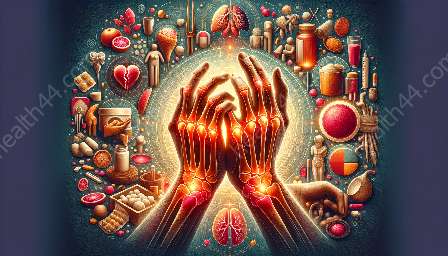Joint damage is a common issue that can have a significant impact on overall health and well-being. It is closely linked to conditions such as gout and other health problems. In this topic cluster, we will delve into the causes, symptoms, and treatment options for joint damage, exploring its connection with gout and other health conditions.
Overview of Joint Damage
Joint damage refers to the degradation of the structures that make up a joint, including bones, cartilage, ligaments, and tendons. This can occur as a result of injury, overuse, or various medical conditions. Joint damage can cause pain, stiffness, and reduced mobility, significantly affecting a person's quality of life.
Causes and Risk Factors
There are several factors that can contribute to joint damage. These include:
- 1. Osteoarthritis: The most common cause of joint damage, osteoarthritis is a degenerative joint disease characterized by the breakdown of cartilage.
- 2. Rheumatoid Arthritis: An autoimmune condition that causes inflammation and joint damage.
- 3. Trauma and Injury: Accidents, sports injuries, and other traumas can lead to immediate or long-term joint damage.
- 4. Gout: Gout is a form of arthritis caused by the buildup of uric acid crystals in the joints, leading to inflammation and joint damage.
- 5. Overuse and Misuse: Excessive or improper use of joints can contribute to wear and tear, resulting in damage over time.
Symptoms
The symptoms of joint damage can vary depending on the underlying cause and the specific joint affected. Common symptoms include:
- Pain and tenderness
- Swelling and inflammation
- Stiffness and reduced range of motion
- Grinding or popping sensations
- Weakness in the joint
- Diabetes: Individuals with diabetes are at a higher risk of developing joint damage, particularly in the form of osteoarthritis.
- Obesity: Excess weight can put added pressure on the joints, leading to accelerated wear and tear and an increased risk of joint damage.
- Cardiovascular Disease: Certain types of arthritis, including rheumatoid arthritis, are associated with an increased risk of cardiovascular problems.
- Autoimmune Disorders: Conditions such as lupus and psoriatic arthritis can lead to joint damage due to the body's immune system attacking its own tissues.
- Medications: Anti-inflammatory drugs, pain relievers, and medications to lower uric acid levels in the case of gout may be prescribed.
- Physical Therapy: Exercises and techniques to improve joint function and reduce pain and stiffness.
- Weight Management: Maintaining a healthy weight can help reduce the strain on the joints and slow the progression of joint damage.
- Surgery: In severe cases, joint replacement surgery or other surgical procedures may be recommended.
Impact on Gout
Gout is a type of arthritis that is strongly linked to joint damage. The accumulation of uric acid crystals in the joints, typical of gout, can lead to severe inflammation, pain, and joint damage. In many cases, gout primarily affects the big toe, but it can also impact other joints such as the ankles, knees, elbows, and wrists.
Connection to Other Health Conditions
Joint damage is not limited to its impact on gout. It can also be associated with other health conditions such as:
Treatment Options
The treatment of joint damage and its associated conditions typically involves a combination of lifestyle modifications, medication, physical therapy, and, in some cases, surgical intervention. Common treatment options include:
Conclusion
Joint damage is a complex issue that can have serious implications for overall health. Understanding the causes, symptoms, and treatment options is essential in managing conditions such as gout and other health problems. By recognizing the connection between joint damage and various health conditions, individuals can take proactive steps to protect their joint health and improve their overall well-being.


